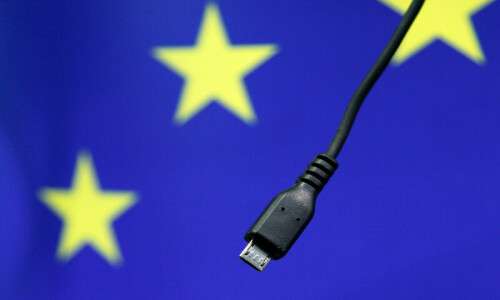H2: Introduction to the EU’s New Universal Charger Legislation
On December 28, 2024, the European Union’s new legislation requiring all new smartphones, tablets, cameras, and various other consumer electronics to be equipped with a single, universal charging port came into effect. This significant regulatory change is expected to simplify consumers’ lives while addressing growing concerns over e-waste and cost burdens related to multiple chargers for different devices.
H3: The USB-C Port: The Future of Charging in the EU
From now on, all new electronic devices sold in the 27-nation bloc will be required to feature the USB-C charging port. The USB-C has emerged as the European Union’s designated universal standard for all charging needs. The regulation mandates that mobile phones, digital cameras, tablets, keyboards, headphones, and speakers—among many other gadgets—will be sold with this common charging solution. The change is the culmination of years of regulatory discussions and debates within the European Parliament.
H2: Benefits of the Universal Charger Rule
The EU believes that the move to a single charger standard will provide multiple benefits for consumers, businesses, and the environment. One of the key advantages is cost savings. With fewer proprietary charging cables in circulation, consumers will no longer have to purchase a new charger with every new device, reducing overall expenditure. Moreover, fewer chargers will need to be produced, which translates into savings for manufacturers.
Another critical benefit is environmental sustainability. The EU anticipates a significant reduction in electronic waste, which has been a growing concern globally. By standardizing the charging port, the law reduces the need for a variety of incompatible chargers, which often end up discarded when a device is upgraded. According to estimates, the change will cut more than 1,000 tonnes of electronic waste annually and save the European economy up to 200 million euros each year.
H3: The Struggle with Apple’s Resistance
When the EU first approved the universal charger rules in 2022, the legislation sparked a notable conflict with Apple, the world’s leading smartphone manufacturer. Apple was initially resistant to the idea, arguing that imposing a universal charging standard would stifle innovation and limit the company’s ability to design its products freely. Apple’s proprietary Lightning port had been in use for years and was a critical part of its ecosystem.
Despite this opposition, Apple gradually embraced the change. By September 2023, Apple began shipping its smartphones equipped with USB-C ports, in compliance with the EU’s directive. While Apple’s reluctance to comply had been well-publicized, the company’s eventual decision marked a pivotal moment in the broader tech industry’s alignment with the new rules.
H2: The Road Ahead for Laptop Makers
While smartphone and smaller electronic device makers are now bound by the new rules, laptop manufacturers will have an additional two years to adapt. Starting in early 2026, laptops sold in the EU will also need to comply with the USB-C standard. Given that many laptops already use USB-C ports for charging, this transition is expected to be relatively seamless. However, this extended deadline provides manufacturers with more time to implement the change and modify their designs accordingly.
H3: Industry Reactions and Future Outlook
The EU’s move to implement a universal charging standard was met with mixed reactions across the tech industry. Many smaller companies and environmental advocates applauded the decision, citing its potential to streamline the consumer experience and reduce the impact of electronic waste. On the other hand, larger tech companies like Apple initially voiced concerns about the potential stifling effect on product innovation.
Now that the regulation has come into force, it is expected that there will be a gradual shift in how manufacturers approach device charging. As the new policy takes effect, companies may begin focusing more on improving device functionality and features instead of investing heavily in unique charging solutions.
H2: How the EU’s Universal Charger Law Affects Consumers
The impact of this law will be felt primarily by consumers, who will benefit from a simplified and more cost-effective charging experience. With the new regulation in place, consumers will no longer need to worry about having multiple chargers for different devices. This will significantly reduce the clutter of unused chargers, allowing users to save both money and space.
H3: Reduction in E-Waste: A Win for the Environment
In addition to its consumer benefits, the EU believes that the new charging regulation will substantially decrease electronic waste. With more standardized charging devices, fewer obsolete chargers will need to be disposed of. E-waste is a major environmental issue, and the EU’s push to reduce it aligns with the region’s broader sustainability goals.
H2: The Wider Global Impact of EU’s Universal Charger Regulation
The EU’s decision to mandate a universal charger is being closely watched by other regions around the world. As the world’s largest consumer market, the EU’s decisions often set trends that impact global markets. With companies like Apple already adapting to the new regulation, other regions may follow suit. In the United States, for example, the pressure to standardize charging ports could grow, especially as environmental concerns become more prominent.
H3: A Potential Catalyst for Global Standardization
The EU’s universal charger law has the potential to accelerate the adoption of a single charging standard globally. As many electronics companies already use USB-C ports in their devices, the rule’s enforcement in Europe could encourage similar legislation in other countries. In particular, regions with a strong environmental focus may see this as a way to reduce electronic waste and simplify the consumer experience.
H2: FAQs About the EU’s Universal Charger Law
Q1: What devices are affected by the EU’s new universal charger rule?
A1: The new rule applies to mobile phones, tablets, digital cameras, headphones, speakers, keyboards, and other electronic devices sold in the EU.
Q2: When did the universal charger rule come into force?
A2: The rule came into force on December 28, 2024, requiring all new devices sold in the EU to be equipped with a USB-C charging port.
Q3: Which companies were initially opposed to the universal charger rule?
A3: Apple was the most notable company to initially oppose the universal charger rule, as it used its proprietary Lightning port for many years.
Q4: How will the universal charger rule benefit consumers?
A4: Consumers will save money by not having to buy new chargers with each device and will reduce the clutter of unused chargers. Additionally, the rule is expected to reduce the overall cost of devices.
Q5: Are laptop manufacturers required to follow this rule immediately?
A5: No, laptop manufacturers have until early 2026 to comply with the universal charger rule and start using USB-C charging ports.
H2: Conclusion: The Future of Charging in Europe
The European Union’s new universal charger rule represents a bold move towards simplifying the tech landscape. By reducing costs, waste, and environmental impact, the law is a win for consumers and the planet. As this regulation comes into effect, it will not only change how Europeans charge their devices but may also inspire global shifts toward more standardized and sustainable technology practices.
SEE ALSO
https://flarenews.pk/2024/12/29/power-minister-awais-highlights-key-reforms-in-energy-sector/



